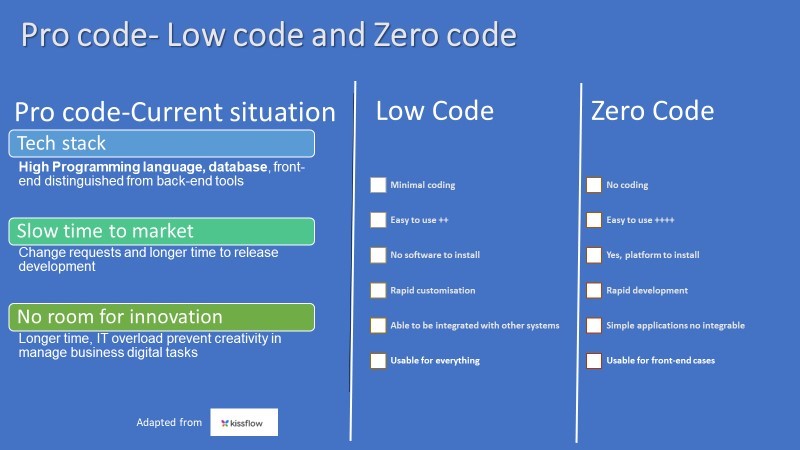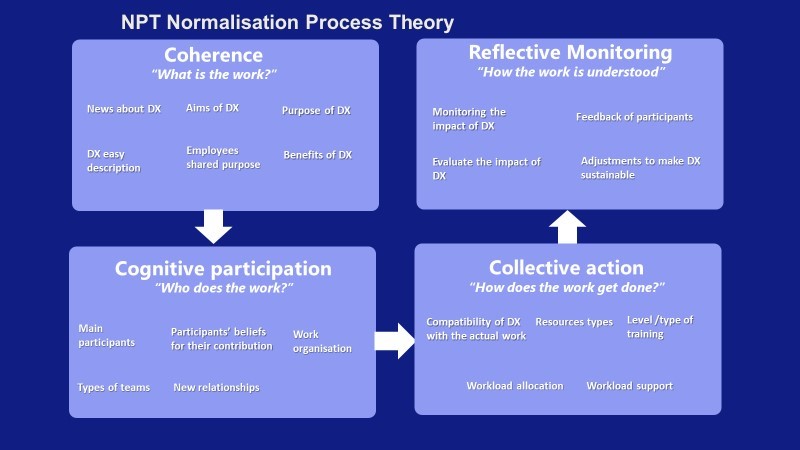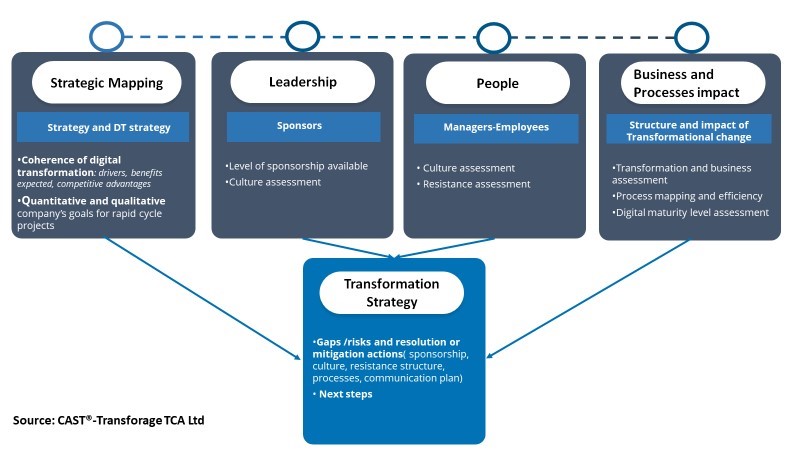Normalising Digital Transformation
In my previous article, “Is Digital Transformation (DX) an opportunity for Management Consultants with SMEs?” published in the January edition of this Newsletter, I provided some evidence that shows how the failure rates of digital transformation are linked to the concept of ‘technology fallacy’, defined as the assumption that the challenges created to business by technology can be only solved by technology itself. I also showed how DX is a viable service for management consultants.
Based on recent research [1] and practices [2], this piece will discuss other aspects related to digital transformation, mainly focusing on the process and people factors rather than modern technology, introducing the concept of Normalisation Process Theory (NPT).
Characteristics of digital transformation: technology enabling the approach of “people first.”
New ways of coding for digital applications
Digital applications and technologies have two main characteristics:
- They can be easily customised;.
- With the low or no-code technology development, people will be able to customise solutions themselves (in a practice known as ‘citizen development’). [3]
A synopsis of the coding types is shown below:

The low and zero coding types shown above can allow experimentation during the transformation process by adopting an agile iterative approach. These rapid projects do not fit any hierarchical structure, as they require working with cross-functional teams, across departmental boundaries and possible silos, and experimenting with new processes in a reduced timespan.
With the new technology, changes can be implemented provisionally and then fine-tuned; decisions can be made rapidly, and people from different departments can work together.
Impact on the change process: adoption and reinforcement vs normalisation
Nowadays, the focus is on the initial adoption of technology rather than the long-term normalisation and maintenance of the digital transformation. While adoption and reinforcement are considered in IT implementations and organisational change, they are not sufficient to guarantee the “normalisation” of a digital transformation. The risk involved would be failing after the first phase and leaving both clients and consultants with a potentially false impression of conclusive achievement.
Top-down approach
The top-down approach is an imposed integration of processes. It is typical of a complex work environment; the new practices introduced are related to the steps involved before engaging the teams. Little time is dedicated to discussing possible changes to work practices.
A pure top-down approach makes employees feel that [4]:
- They don’t have control over the change.
- They are detached from the solution because the latter does not match their context and the complexities of the practice.
The concept of “Normalising” [5]
By normalising, we mean embedding and sustaining a digital transformation.
Why? We need to accept that
- Digitalisation is an evolving process (technology evolution, increased capacity to gather and store more data, improved rapid communications and elaboration speed).
- Customers use technology that becomes more embedded in their everyday lives, increasing their expectations.
Thus, normalisation means that a process needs to be rearranged and aligned continuously.
Bottom-up approach and normalisation: NPT
I propose the use of a bottom-up approach, based on the use of Normalisation Process Theory (NPT) and focusing on the analysis, implementation, and integration of new technologies and organisational innovations. NPT explains how complex interventions
can fit into regular work. Before deciding which digital tools to use and how to utilise them, the focus should be on changing the mindset and culture of the organisation as well as on increasing the level of engagement in the process.
Normalisation Process Theory (NPT)
The Normalisation Process Theory [6] was developed to define issues and propose solutions in complex implementations by integrating new technology and organisational innovations. This is aimed at facilitating the employees’ use of the implementation in their routine and turning it into a new behaviour.
The NPT theory was developed through distinct phases: the first one included the elements of embedding processes [7], and introduced the concept of normalisation.
The second phase was focused on the identification and explanation of the aspects which can encourage or impede the execution of work tasks in a complex implementation process (for example clinical trials, mental health, telemedicine systems, decision-making processes) [8].
The last phase of theory development was based on how people use the outcomes of complex implementation in their practices and adopt them as part of their behaviour at work [9].
A general theory of implementation based on NPT was developed in 2013 [10].
Elements of NPT
Coherence
When a change process starts, a key priority is to give employees the opportunity to talk about how they understand new practices and what the aims and benefits of the implementation are supposed to be. The change process is thus re-located within the core team rather than with other project people.
Cognitive participation
The next step is to build an increasing understanding of what employees and teams are expected to do and the responsibilities within cross-functional activities required to move the new operations forward. Here critical reflection may identify what operations can be embedded with digital tools.
Collective action
This phase is about identifying the resources needed and the new skills that will be required, more specifically the time, resources, and training that will be needed to embed digital solutions in order to carry out the implementation and normalisation processes successfully.
Reflective Monitoring
This process requires feedback from the participants. The core idea behind a bottom-up approach is for the team to take responsibility for adjusting/amending the digital solutions of the new operations so that they fit their context and the team can then “normalise” them.

Conclusions
- Employees need to participate in building organisational practices because, thanks to their knowledge, they can quickly understand what can or cannot work.
- Experience already gained by employees also helps them manage external stakeholders in terms of performance feedback, changing needs, and new priorities.
- The NPT approach can reduce or even eliminate the fear that “technology can replace employees”, a major factor in creating resistance. Instead, a digital transformation project should be seen as a real opportunity for employees to upskill themselves.
- High-innovation projects are one root cause of mass resignations, even when the innovation is effective. This is because it can promote burnout [11] if it is forced on employees.
Takeaways for Management Consultants
The NPT approach is a way of reducing resistance and other difficulties encountered in digital transformation when it comes to embedding technology in day-to-day operations. It can be considered a non-prescriptive approach, which may also change the consultant’s offering and the value proposition. Essential consulting skills here include facilitation, coaching and functional validation. However, the main elements of
- Strategic mapping vs digital goals (coherence)
- Leadership (sponsorship validation)
- People (resistance and culture assessment)
- Impact on business and processes
remain strategic and functional in the transformational-change process to develop a successful digital transformation strategy.

Luca Collina MBA, a Transformational and growth management consultant, the founder of Transforage TCA, a member of WCoMC and a champion of CMCE work.
References
[1] Carrol, N., 2020.Theorizing on the Normalization of Digital Transformations, Twenty-Eight European Conference on Information Systems (ECIS2020), Marrakesh, Morocco, pp.1-17
[2] Tabrizi, B., Lam, E., Girard, K. and Irvin, V., 2019. Digital transformation is not about technology. Harvard business review, 13(March), pp.1-6.
[3] Carroll, N., McCaffery, B., Conboy, K. and Donnellan, B., 2021. Normalising a Digital Transformation.
[4] Wood, P., 2017. Overcoming the problem of embedding change in educational organizations: A perspective from Normalization Process Theory. Management in Education, 31(1), pp.33-38.
[5]Carroll, N., McCaffery, B., Conboy, K. and Donnellan, B., 2021. Normalising a Digital Transformation
May, C. and Finch, T., 2009. Implementing, embedding, and integrating practices: an outline of normalization process theory. Sociology, 43 (3), pp.535-554.
[6] May CR, Mair F, Finch T, Macfarlane A, Dowrick C, Treweek S, Rapley T, Ballini L, Ong BN, Rogers A, Murray E, Elwyn G, Légaré F, Gunn J, Montori VM., 2009. Development of a theory of implementation and integration: normalization process theory. Implement Sci. 4:29.
[7] May, C., Mort, M., Williams, T., Mair, F. S. and Gask, L., 2003a. 'Health Technology Assessment in its local contexts: studies of telehealthcare', Social Science and Medicine 57: 697-710.
May, C. R., Harrison, R., Finch, T., MacFarlane, A., Mair, F. S. and Wallace, P., 2003b. 'Understanding the normalization of telemedicine services through qualitative evaluation', Journal of the American Medical Informatics Association 10(6): 596-604.
[8] (May 2006) (May, et al. 2007a) (May, et al. 2007b) (Gask, et al. 2008) (Finch, et al. 2007); (Mair, et al. 2008) (Elwyn, et al. 2008)
[9] May, C. and Finch, T., 2009. 'Implementation, embedding, and integration: an outline of Normalization Process Theory', Sociology 43 (3): 535-554
[10] May, C., 2013, Towards a general theory of implementation. Implementation Sci 8, 18
[11] https://www.inc.com/jessica-stillman/great-resignation-mit-revelio-research.html